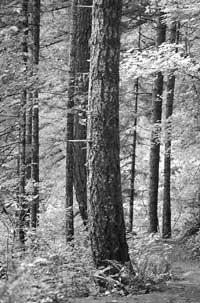Human Footprint
2004/02/08 Rementeria Argote, Nagore - Elhuyar Zientziaren Komunikazioa

In the morning we wake up to the alarm clock, turn on the light, get up and shower with hot water; dressed in clean clothes, have breakfast a beautiful coffee with milk and go by car to work. But have we ever thought about where the clothes, food, electricity, water or fuels we use come from in our daily lives?
Today's children rarely tie milk inside the refrigerator with the cow, which is in a clean tetrabrik. And they are not the only ones who believe that the apparatuses and materials around us have nothing to do with nature, as if things were out of nowhere. Of course most products are produced in the industry, but don't workshops need natural raw materials?
Also, it seems that we are very clean. Look, if not, the activity of daily life: we buy in the store the necessary supplies and products, we use them and when they are not necessary we throw them away. Somehow, the system is organized so that citizens see the least amount of waste possible and, in addition, by classifying waste in recycling homes, we do not think we generate too much waste, it seems that we are able not to harm nature.
But have we ever thought about the path a product has taken to the buyer? Or what will happen to the deposited waste? Thinking about it, it is possible that the Earth does not suffer human activities and that disaster does not turn back.
Measuring footprint

There is a tool to measure the environmental impact of human activities, called ecological footprint. The unit of the ecological footprint is the fertile land surface. Thus, the damage caused by human activity passes to surface units by mathematical formulas.
The base is formed by the land where food is produced and the necessary to obtain the wood used to heat it, along with the area necessary to absorb the carbon monoxide produced by the fuel consumed. However, other factors taken into account when calculating the ecological footprint are the imported or exported industrial product.
Each inhabitant of the Earth has an average ecological footprint of 2.8 units of surface, that is, it uses almost three hectares of fertile soil. This unit of surface is not, logically, a real land; for its use as a unit has been defined a hectare of land with an average fertility of land and land seas. A surface unit is approximately 0.3 hectares of rural land or 16.3 hectares of sea.

The ecological footprint is calculated by an average. The ecological footprint of the inhabitants of a country or city is normally calculated. This makes it possible to compare the footprints of various peoples. And, as expected, it is developed countries that have the greatest ecological footprint and, on the contrary, the poorest ones that generate the least ecological footprint.
The ecological footprint of the Spanish is an average of 5.4 units of surface, almost double the world average and that of the French 7,27. These amounts are well above the average of the world's population. For example, the footprint of the inhabitants of India is of a single surface unit and that of the Chinese of 1.84. Therefore, the ecological footprint clearly shows the difference between developed and underdeveloped countries.
Will the world endure?
Knowledge of the ecological footprint can have interesting consequences. When compared, among other things, with the amount of fertile soil on Earth, it is evident that the current level of consumption is unsustainable and that it is necessary to reverse the situation. In fact, if the land of the world is distributed among all human beings, it is observed that each has two hectares. And since the ecological footprint is 2.8, the main conclusion is that each inhabitant exploits 0.8 hectares more than the corresponding.

How is it possible? So far we have not even mentioned the rest of the world, but to conserve biodiversity a percentage of the Earth's surface is out of calculation, only 12%. And it is that each of us steals 12% to be able to use more than we owe.
Moreover, it is not the only injustice, as developed countries do not only affect their territory. Current markets have no borders and products are easily transported from one end to another. Thus, the inhabitants of the developed peoples also influence the last corner of the world.
The Basques should not look from afar, because we are undoubtedly responsible for the excessive ecological footprint of the world. What, don't you think? As you calculate your ecological footprint on one of the websites, I don't think you get very good news.
Published in 7K.

Gai honi buruzko eduki gehiago
Elhuyarrek garatutako teknologia





